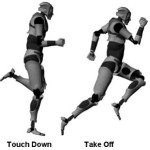Here is a detailed explanation of the pelvis and thorax kinematic sequence curves from TPI 3D, focused around transition. They display how transition occurs and there is a lot of information that can be gleaned from them. They relate directly to the spine rotation graph also. So for TPI 3D techies here we go. The two above graphs have time in seconds along the X-axis … [Read more...]
The Biomechanics of Elite Sprinters
I recently attended the annual track and field summit that included sessions on sprints, hurdles, throws and jumps. I especially enjoyed the seminars by Dr. Ralph Mann on sprint mechanics. Here are some of the main points that I picked up. Ralph emphasizes “front side” mechanics rather than “back side” mechanics. It is a mistake to think that you should push vigorously … [Read more...]
The Importance of Stretching the X-Factor in the Downswing of Golf: The X-Factor Stretch
Back in 2000 my colleagues and I wrote a paper where we showed that an increase in the X-Factor at the beginning of the downswing seemed to be more important that the X-Factor itself. We called this the “X-Factor Stretch”. Jim McLean is well known for his teaching of the X-Factor and has also mentioned in several articles that the hips should turn into the downswing before … [Read more...]
When does the Pelvis Begin to Decelerate in the Downswing of Golf?
In order to create maximum speed of a distal segment or implement, the principle of the kinematic sequence (a.k.a kinetic link) shows that each body part, should accelerate then decelerate in a sequential manner. For the golf swing, to achieve maximum club speed, the sequence is pelvis, thorax (ribcage), lead arm, club shaft. This means that during the downswing the pelvis … [Read more...]
Working with BMW and Athletics on Biomechanics Technology
Here is a short article in Wired Magazine Online. It talks about the project I am working on with BMW and Track and Field. BMW engineers developing software for a 3D camera with the goal to track the athletes running velocity. This will help us do performance testing on a regular … [Read more...]




